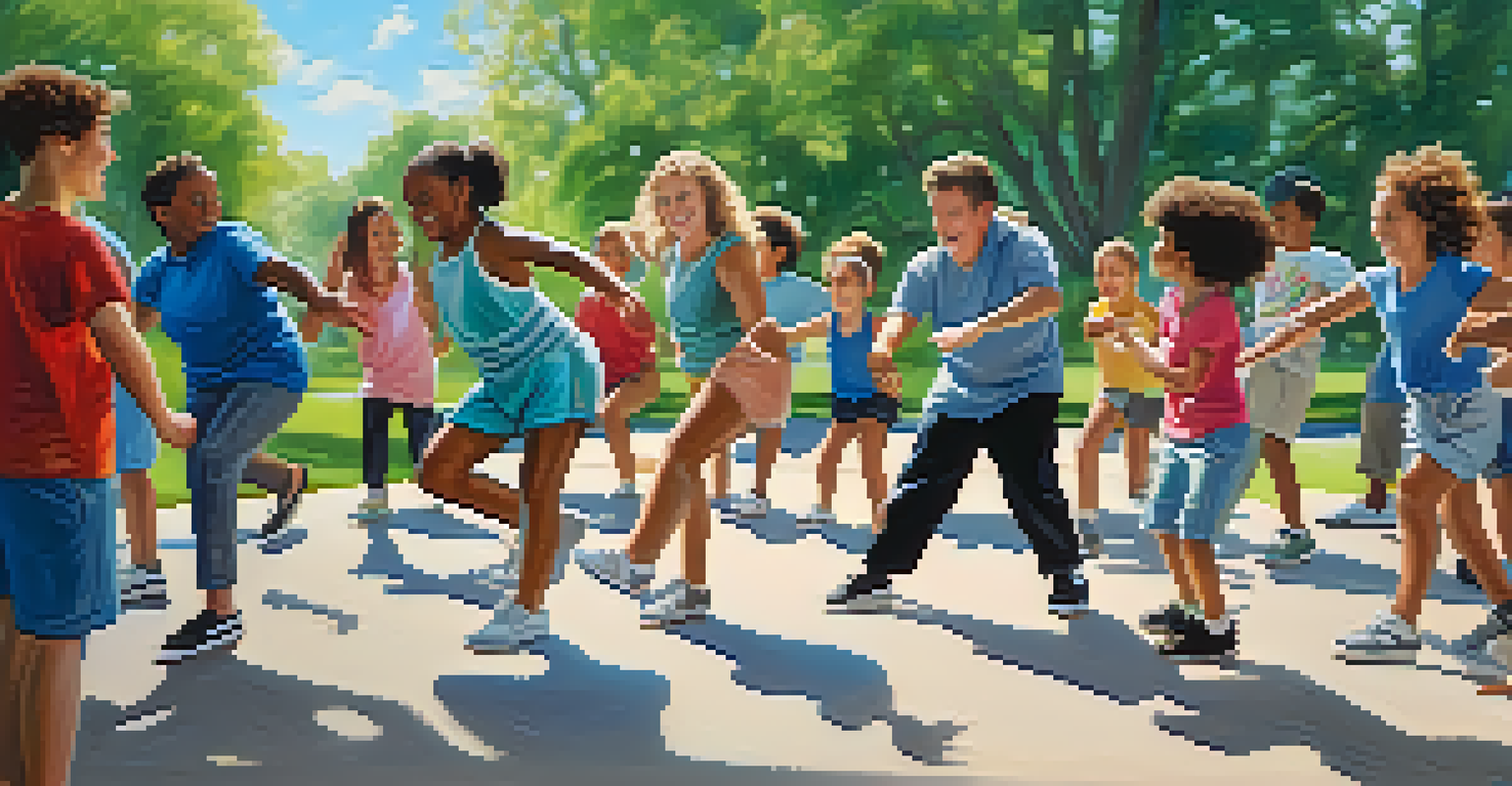Historical Roots of Tap Dance and Its Modern Interpretations

The Origins of Tap Dance: A Cultural Melting Pot
Tap dance emerged in the early 19th century, drawing from various cultural influences. Its roots can be traced back to African rhythms, Irish jigs, and English clog dancing, creating a unique fusion of styles. This blend of traditions made tap dance a vibrant expression of the diverse communities that contributed to its development.
Tap dance is a celebration of culture, rhythm, and the human spirit.
The use of percussive footwork in tap dance was especially significant among African American communities, who infused their cultural heritage into the art form. As they faced societal challenges, tap became a means of both expression and resistance, showcasing their creativity and resilience. The rhythmic clapping and stomping offered a way to celebrate their identity and heritage.
As tap dance began to gain popularity, it became a staple in minstrel shows, vaudeville, and eventually Broadway. This exposure helped to elevate tap dance into the mainstream, allowing it to evolve and adapt while retaining its rich cultural significance. The blending of different dance styles and influences laid the groundwork for what tap dance would become.
The Evolution of Tap Dance in the 20th Century
The 20th century marked a significant turning point for tap dance, especially during the Jazz Age. This era celebrated improvisation and syncopation, and tap dancers became prominent figures in jazz music, collaborating with musicians to create a dynamic performance art. Dancers like Bill 'Bojangles' Robinson and Fred Astaire brought tap to new heights, showcasing their talent on stage and screen.

As tap dance continued to evolve, it absorbed elements from other dance forms, including ballet and modern dance. This cross-pollination allowed tap to grow and adapt, attracting a wider audience and inspiring new generations of dancers. The introduction of rhythm tap, which focuses on intricate footwork and musicality, further expanded the vocabulary of tap dance.
Cultural Roots of Tap Dance
Tap dance originated from a blend of African, Irish, and English influences, creating a vibrant expression of diverse cultural heritage.
By the mid-20th century, tap faced challenges due to the rise of rock and roll and other dance styles. However, it remained resilient, with artists like Gregory Hines and Savion Glover revitalizing interest in tap through innovative performances that highlighted its rich history and potential for creativity. These dancers brought tap into the contemporary spotlight, bridging the gap between tradition and modernity.
The Role of Tap Dance in Film and Television
Tap dance has enjoyed a long and celebrated relationship with film and television, beginning in the 1930s. Iconic films like 'Top Hat' and 'Singin' in the Rain' featured dazzling tap numbers that captivated audiences and showcased the artistry of the dancers. The combination of music, choreography, and visual storytelling brought tap dance to the forefront of American entertainment.
The best thing about being a tap dancer is that you can express yourself through your feet.
Television, too, played a crucial role in popularizing tap dance from the mid-20th century onward. Shows like 'Soul Train' and 'Dancing with the Stars' have featured tap routines, introducing the art form to new audiences while celebrating its history. These platforms have provided opportunities for dancers to showcase their skills and creativity, keeping the spirit of tap alive.
Today, films such as 'Happy Feet' and documentaries focusing on tap continue to highlight the unique qualities of this dance form. By incorporating tap into contemporary narratives and styles, filmmakers keep the tradition alive while inspiring future generations to take up the dance. The ongoing presence of tap in media ensures that its rich history and cultural significance are not forgotten.
The Influence of Tap Dance on Contemporary Choreography
Modern choreography has been significantly influenced by the rhythms and techniques of tap dance. Choreographers often incorporate tap elements into various dance styles, blending them with hip-hop, jazz, and contemporary dance. This fusion creates a fresh, innovative approach that appeals to diverse audiences and keeps tap relevant in today’s dance scene.
Additionally, tap dance's emphasis on musicality and improvisation has inspired choreographers to think outside the box. The ability to express emotions through footwork allows for a unique storytelling method that resonates with viewers. This connection between music and movement enriches the overall experience of dance performances.
Evolution Through the Decades
The 20th century saw tap dance evolve significantly, particularly during the Jazz Age, as it absorbed elements from various dance styles and adapted to changing musical trends.
By embracing tap dance in contemporary works, choreographers honor the art form's history while pushing its boundaries. The integration of tap into new styles showcases the versatility of this dance and encourages collaboration among dancers from different backgrounds, ensuring that tap continues to evolve and thrive.
Educational Programs and the Future of Tap Dance
As interest in tap dance continues to grow, educational programs and dance schools have emerged to nurture future talent. Many institutions now offer specialized tap classes, focusing on technique, rhythm, and creativity. These programs help to instill a strong foundation in aspiring dancers while celebrating the rich history of tap dance.
Workshops and community programs also play a vital role in keeping tap dance accessible to all ages and backgrounds. By providing opportunities for hands-on learning, these initiatives foster a sense of community among dancers and encourage collaboration. This grassroots approach helps to ensure that tap dance remains a vibrant and inclusive art form.
Looking ahead, the future of tap dance appears promising as it continues to evolve and adapt to contemporary trends. With the ongoing influence of social media, tap dancers can showcase their skills and connect with audiences worldwide. This visibility not only promotes the art form but also inspires a new generation of dancers to embrace the rhythm of tap.
Exploring the Global Influence of Tap Dance Today
Tap dance has transcended its American roots, gaining popularity across the globe. Dancers from various cultures have embraced tap, infusing their unique styles and rhythms into the art form. This global exchange has enriched tap dance, making it a diverse and vibrant expression of creativity.
In countries like Japan, tap has found a dedicated following, with dancers exploring its percussive elements while incorporating traditional Japanese dance. Similarly, in Europe, tap festivals and competitions celebrate the art form, showcasing the talents of dancers from different backgrounds. This international interest helps to foster a broader appreciation for tap dance as a universal language of expression.
Global Influence of Tap Dance
Today, tap dance has transcended its American roots, gaining popularity worldwide and incorporating unique styles and rhythms from various cultures.
As tap dance continues to spread worldwide, it serves as a bridge between cultures and generations. The collaborative nature of tap encourages dancers to learn from one another and explore new ideas while honoring the art form's history. This ongoing dialogue ensures that tap remains dynamic and relevant, celebrating its roots while embracing the future.
The Lasting Impact of Tap Dance on Arts and Culture
Tap dance's influence reaches far beyond the stage, leaving a lasting impact on arts and culture. Its rhythmic footwork and improvisational nature inspire musicians, visual artists, and performers alike, creating a rich tapestry of creativity. This cross-disciplinary influence highlights the interconnectedness of the arts and the importance of collaboration.
Moreover, tap dance serves as a powerful medium for social commentary and storytelling. Through its history, tap has addressed themes of identity, struggle, and resilience, allowing artists to communicate their experiences and perspectives. This ability to convey deep emotions through movement underscores the significance of tap dance as an art form.

As we look to the future, the legacy of tap dance will undoubtedly continue to inspire and influence new generations of artists. By embracing its rich history while exploring innovative interpretations, tap dance remains a vital part of our cultural landscape. Its enduring spirit of creativity and expression ensures that tap will resonate for years to come.